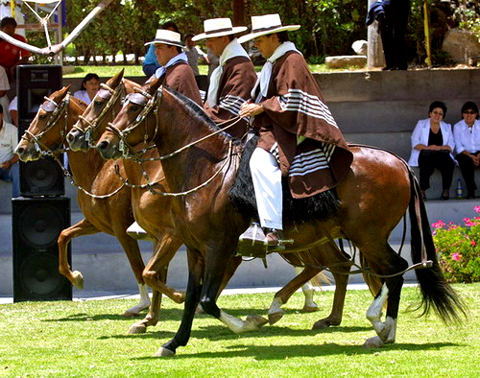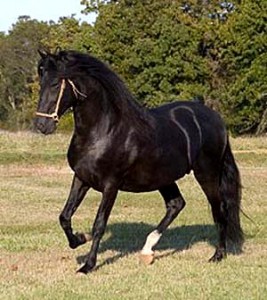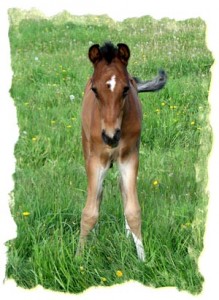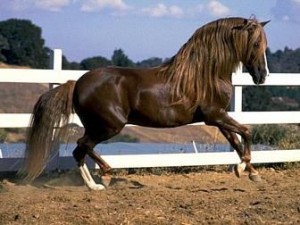
From Wikipedia:
“The Peruvian Paso or Peruvian Horse is a breed of light pleasure saddle horse known for its smooth ride. It is distinguished by a natural, four-beat, lateral gait called the paso llano.
“Peruvian Paso horses are noted internationally for their good temperament and comfortable ride. As of 2003, there are approximately 25,000 horses worldwide, used for pleasure riding, trail, horse shows, parades, and endurance riding
“Smooth-gaited horses, generally known as Palfreys, existed in the Middle Ages, and the Jennet in particular was noted for its ambling gaits. Peruvian Pasos trace their ancestry to these ambling Jennets; as well as to the Barb, which contributed strength and stamina; and to the Andalusian which added style, conformation and action.
“Horses arrived in South America during the Spanish Conquest, beginning the arrival of Pizarro in 1531. Foundation bloodstock came from Spain, Jamaica, Panama and other areas of Central America. .
“Once in Peru, they were used primarily for transportation and breeding stock. In the north of Peru, the vast size of sugar and cotton plantations meant that overseers needed to travel long distances, often taking days to cross the plantation. In the south of Peru, the arid deserts that separated settlements required sturdy, strong horses. In both cases, smooth-gaited horses with good endurance were required. On the other hand, Peru did not develop a livestock-based economy, and thus did not need to breed for the speed or agility characteristic of stock horses.
 “Over time, Peruvian breeders kept the bloodlines clean and selectively bred primarily for gait, conformation, and temperament. They wanted strong, hardy animals that were comfortable to ride and easy to control. Over four centuries, their dedication to breeding only the best gaited bloodstock resulted in the modern Peruvian Paso.
“Over time, Peruvian breeders kept the bloodlines clean and selectively bred primarily for gait, conformation, and temperament. They wanted strong, hardy animals that were comfortable to ride and easy to control. Over four centuries, their dedication to breeding only the best gaited bloodstock resulted in the modern Peruvian Paso.
“The Peruvian Paso continued to flourish in the northern regions because it was still needed for transportation on the haciendas. This changed with the harsh Agrarian Reforms instituted by the government of Juan Velasco Alvarado in the late 1960s that had a devastating effect on the Peruvian Paso horse within Peru. Major breeding operations were broken up and breeding stock was lost. Because interest in the Peruvian Paso horse was growing in the United States and Central America at the same time, many of the finest Peruvian Paso horses were exported, leading to a period where it appeared the Peruvian Paso horse would fade in its homeland.
Appearance
“The horse is medium sized, usually standing between 14.1 and 15.2 hands tall, with an elegant yet powerful build. The Peruvian horse has a deep chest, heavy neck and body with substance without any trace of being hound gutted in the flank area. A low set, quiet tail, clamped tightly between the buttocks is a vital quality. Stallions have a broader chest and larger neck than mares, and are known for their quality temperament. The coat color can be varied; and is seen in chestnut, black, bay, brown, buckskin, palomino, gray, roan or dun. Solid colors, grays and dark skin are considered the most desirable. The mane and forelock are lustrous, fine and abundant. White markings are acceptable on the legs and face.
“Instead of a trot, the Peruvian Paso performs an ambling four beat gait between the walk and the canter. It is a lateral gait, in that it has four equal beats and is performed laterally — left hind, left fore, right hind, right fore.
“The Peruvian Paso performs two variations of the four-beat gait. The first, the paso llano (a contraction of Paso Castellano), is isochronous, meaning that there are four equal beats in a 1-2-3-4 rhythm. This is the preferred gait. The second gait, the sobreandando, is faster. Instead of four equal beats, the lateral beats are closer together in a 1-2, 3-4 rhythm, with the pause between the forefoot of one side to the rear of the other side is longer.
 “This characteristic gait was utilized for the purpose of covering long distances over a short period of time without tiring the horse or rider. The gait is natural and does not require extensive training. Purebred Peruvian Paso foals can be seen gaiting alongside their dams within a few hours of their birth.
“This characteristic gait was utilized for the purpose of covering long distances over a short period of time without tiring the horse or rider. The gait is natural and does not require extensive training. Purebred Peruvian Paso foals can be seen gaiting alongside their dams within a few hours of their birth.
“The gait supplies essentially none of the vertical bounce that is characteristic of the trot, and hence posting (moving up and down with each of the horse’s footfalls) is unnecessary. It is also very stable, as the execution of the gait means there are always two, and sometimes three, feet on the ground. Because the rider feels no strain or jolt, gaited horses such as the Peruvian Paso are often popular with riders who have back trouble.”
You can learn about Peruvian Paso breeders by clicking HERE.
If you have problems seeing the video below click HERE.
youtube::j0chjCSt-wE::
And a very cool Marinera dance. If you have problems seeing the video below click HERE
.youtube::4Q_mBLnYwIw::

